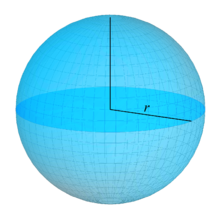
Back Fläche (Mathematik) German Επιφάνεια (μαθηματικά) Greek Superficie (matemática) Spanish رویه (ریاضیات) Persian Surface (géométrie analytique) French 曲面 (数学) Japanese Bề mặt (toán học) Vietnamese
This article needs additional citations for verification. (February 2022) |

In mathematics, a surface is a mathematical model of the common concept of a surface. It is a generalization of a plane, but, unlike a plane, it may be curved; this is analogous to a curve generalizing a straight line.
There are several more precise definitions, depending on the context and the mathematical tools that are used for the study. The simplest mathematical surfaces are planes and spheres in the Euclidean 3-space. The exact definition of a surface may depend on the context. Typically, in algebraic geometry, a surface may cross itself (and may have other singularities), while, in topology and differential geometry, it may not.
A surface is a topological space of dimension two; this means that a moving point on a surface may move in two directions (it has two degrees of freedom). In other words, around almost every point, there is a coordinate patch on which a two-dimensional coordinate system is defined. For example, the surface of the Earth resembles (ideally) a sphere, and latitude and longitude provide two-dimensional coordinates on it (except at the poles and along the 180th meridian).